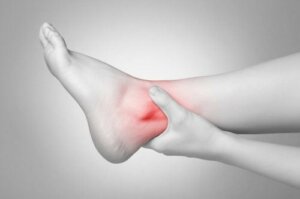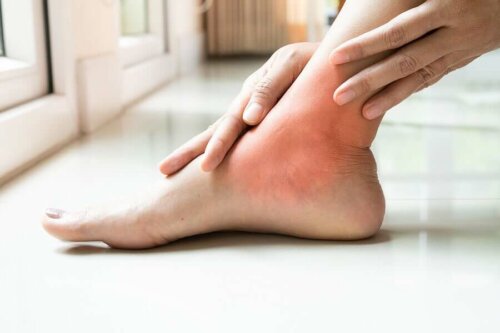Five Warning Signs From Swollen Ankles


Written and verified by the doctor Nelton Abdon Ramos Rojas
Commonly, having swollen ankles can be due to fluid retention or an injury after making a certain movement, but not only that. There are other reasons to be aware of and we’ll discuss them in more detail below.
It is important to take into account the possible causes and go to the doctor to find out what is affecting you directly so that you can then begin appropriate treatment.
The treatment usually consists of a series of very simple measures. On the other hand, there are complementary methods that help get relief from certain discomforts.
1. Weak blood vessels

Often, patients come to the office and mention their discomfort and make reference to the fact that they have poor circulation and their intuition may not fail them. Swollen ankles and other discomforts can occur as a result of this and, in particular, a vascular problem.
Vascular diseases in the lower extremities are classified as arterial or venous:
- Arterial diseases may come from a local defect in the arteries, like aneurysms. They can also happen as a result of other diseases like arteriosclerosis.
- Venous diseases include varicose veins and venous thromboses.
According to the MSD Manual: “chronic venous insufficiency is damage to the veins in the legs that prevents blood from flowing normally. The post-phlebitic syndrome is chronic venous insufficiency caused by a blood clot in the veins.
Read about the Six Bad Habits That Age You Faster Without You Noticing It
2. Swollen ankles might be a warning sign for blood clots
Blood clots in the leg veins can be the cause of swollen ankles and other discomforts.
MedicalNewsToday experts explain: “If blood clots develop in the veins of the legs, they can prevent blood from returning to the heart. This can cause your ankles and feet to swell.” They add that deep vein thrombosis (DVT) occurs when blood clots form in the legs. In these cases, the person may also experience:
- Pain
- Low-grade fever
- Changes in skin color, such as darkening or pallor
3. Exercises done incorrectly
If you exercise on your own, you run the risk of doing it improperly. Just to be sure, check for any swelling in your ankles.
But don’t confuse general swelling with muscular inflammation.
- The second one is different because it usually comes along with the pain you feel on the inside, rather than superficially.
- Muscular inflammation is more common in a single limb. If it happens in both, you should ask yourself if you’re exercising incorrectly or using the wrong footwear.
4. Poor lifestyle habits

Just as a balanced diet can contribute greatly to health, a diet rich in salt and fat can harm it and lead to all kinds of problems, such as fluid retention and swelling of the extremities. On the other hand, smoking and alcoholism often trigger several health problems and, in turn, reinforce others.
You might like Five Ways to Sleep Better
5. Reaction to medication
If you’re taking a new medication, you might be having a negative reaction. Most drugs have numerous side effects, including swelling. For example, drugs for diabetes, antidepressants, non-steroidal anti-inflammatory drugs, corticosteroids, among others.
It’s best to see your doctor. In some cases, it’s a side effect you’ll just have to put up. But in others, it’s a sign that you need a different dose or a switch to a different medication.
Natural remedy to relieve swollen ankles

In addition to following the doctor’s instructions, to obtain the relief it’s also possible to resort to certain measures. For example, you can prepare chamomile tea or use a chamomile essential oil to lightly massage the area.
This oil has anti-inflammatory properties, so it’s used to obtain relief from swelling.
Ingredients
- 2 c. of water
- Chamomile essential oil
- 2 tbsp. of chamomile flowers
Preparation
- Heat the water and once it starts to boil, add the chamomile
- Secondly, let stand for 10 minutes
- Thirdly, add the chamomile flowers and let sit for an additional 5 or 6 minutes
- Then, remove from heat and wait for it to cool
- Strain and pour over the legs in small amounts
- Finally, massage from the feet to the knees with circular motions
Remember this remedy can contribute to relief, but it isn’t a cure for the problem as such. Thus, use it only as a complement to any treatment your doctor prescribes upon their approval.
All cited sources were thoroughly reviewed by our team to ensure their quality, reliability, currency, and validity. The bibliography of this article was considered reliable and of academic or scientific accuracy.
- Reinhold-Keller, E., & Wagner-Bastmeyer, R. (2007). [Painful and swollen ankles: no arthritis]. Zeitschrift Für Rheumatologie. https://doi.org/10.1007/s00393-007-0166-4
- Rooney, M. E., McAllister, C., & Burns, J. F. T. (2009). Ankle disease in juvenile idiopathic arthritis: Ultrasound findings in clinically swollen ankles. Journal of Rheumatology. https://doi.org/10.3899/jrheum.080508
- Fogelson, A. L., & Neeves, K. B. (2015). Fluid Mechanics of Blood Clot Formation. Annual Review of Fluid Mechanics. https://doi.org/10.1146/annurev-fluid-010814-014513
This text is provided for informational purposes only and does not replace consultation with a professional. If in doubt, consult your specialist.








